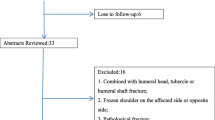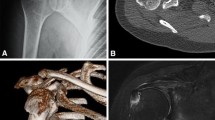Abstract
Purpose
The aim of this study was to evaluate the early clinical outcomes of arthroscopic treatment of avulsion or comminuted fractures of the greater tuberosity (GT) using a modified suture-bridge technique.
Methods
Between February 2013 and November 2015, 14 patients with displaced or comminuted fractures of GT were arthroscopically treated using a modified suturebridge technique. Displacement of the GT fragments was > 3 mm in any plane. An analysis of follow-up results including the University of California, Los Angeles (UCLA) shoulder scale; the shoulder index of the American Shoulder and Elbow Surgeons (ASES); the simple shoulder test (SST); and shoulder range of motion (ROM), is presented.
Results
Mean duration of follow up is 18.9 months (range, 6–30). Mean age of patients was 62.9 years (range, 49–74). Postoperatively, the outcomes were rated as excellent, good and fair in two, 11 and one patient, respectively based on the UCLA score. At the most recent follow-up, the average UCLA score increased to 32 points, the ASES score increased to 97.5 points, and the SST score increased to 11 points. Average forward flexion was 153.6°, average abduction was 158.6°, average external rotation in the neutral position was 38.6°, and internal rotation increased to the 12th thoracic vertebral level.
Conclusion
Early follow-up outcomes of the arthroscopic modified suture-bridge technique used for avulsion or comminuted GT fractures are promising. The technique can be used as one of the therapeutic modalities for GT fractures.






Similar content being viewed by others
References
Court-Brown CM, Garg A, McQueen MM (2001) The epidemiology of proximal humeral fractures. Acta Orthop Scand 72(4):365–371. doi:10.1080/000164701753542023
Gruson KI, Ruchelsman DE, Tejwani NC (2008) Isolated tuberosity fractures of the proximal humeral: current concepts. Injury 39(3):284–298. doi:10.1016/j.injury.2007.09.022
Neer C (1970) Displaced proximal humeral fractures. I. Classification and evaluation. J Bone Joint Surg Am 52(6):1077–1089
Bigliani LU, Flatow EL, Pollock RG (1998) Fractures of the proximal humerus. In: Rockwood CA, MatBen FA, (eds) The shoulder. WB Saunders, Philadelphia, pp 337-389
Park MC, Murthi AM, Roth NS, Blaine TA, Levine WN, Bigliani LU (2003) Two-part and three-part fractures of the proximal humerus treated with suture fixation. J Orthop Trauma 17(5):319–325
Dimakopoulos P, Panagopoulos A, Kasimatis G (2007) Transosseous suture fixation of proximal humeral fractures. J Bone Joint Surg Am 89(8):1700–1709. doi:10.2106/JBJS.F.00765
Flatow EL, Cuomo F, Maday MG, Miller SR, McIlveen SJ, Bigliani LU (1991) Open reduction and internal fixation of two-part displaced fractures of the greater tuberosity of the proximal part of the humerus. J Bone Joint Surg Am 73(8):1213–1218
Herscovici D Jr, Saunders DT, Johnson MP, Sanders R, DiPasquale T (2000) Percutaneous fixation of proximal humeral fractures. Clin Orthop Relat Res 375:97–104
Dimakopoulos P, Panagopoulos A, Kasimatis G, Syggelos SA, Lambiris E (2007) Anterior traumatic shoulder dislocation associated with displaced greater tuberosity fracture: the necessity of operative treatment. J Orthop Trauma 21(2):104–112. doi:10.1097/BOT.0b013e3180316cda
Park S-E, Jeong J-J, Panchal K, Lee J-Y, Min H-K, Ji J-H (2016) Arthroscopic-assisted plate fixation for displaced large-sized comminuted greater tuberosity fractures of proximal humerus: a novel surgical technique. Knee Surg Sports Traumatol Arthrosc 24(12):3892–3898
Ellman H, Hanker G, Bayer M (1986) Repair of the rotator cuff. End-result study of factors influencing reconstruction. J Bone Joint Surg Am 68(8):1136–1144
Roddey TS, Olson SL, Cook KF, Gartsman GM, Hanten W (2000) Comparison of the University of California-Los Angeles shoulder scale and the simple shoulder test with the shoulder pain and disability index: single-administration reliability and validity. Phys Ther 80(8):759–768
Coghlan JA, Bell SN, Forbes A, Buchbinder R (2008) Comparison of self-administered University of California, Los Angeles, shoulder score with traditional University of California, Los Angeles, shoulder score completed by clinicians in assessing the outcome of rotator cuff surgery. J Shoulder Elbow Surg Am 17(4):564–569
Wylie JD, Beckmann JT, Granger E, Tashjian RZ (2014) Functional outcomes assessment in shoulder surgery. World J Orthop 5(5):623–633. doi:10.5312/wjo.v5.i5.623
Michener LA, McClure PW, Sennett BJ (2002) American shoulder and elbow surgeons standardized shoulder assessment form, patient self-report section: reliability, validity, and responsiveness. J Shoulder Elbow Surg Am 11(6):587–594. doi:10.1067/mse.2002.127096
Beaton D, Richards RR (1998) Assessing the reliability and responsiveness of 5 shoulder questionnaires. J Shoulder Elbow Surg Am 7(6):565–572
Kocher MS, Horan MP, Briggs KK, Richardson TR, O’Holleran J, Hawkins RJ (2005) Reliability, validity, and responsiveness of the American shoulder and elbow surgeons subjective shoulder scale in patients with shoulder instability, rotator cuff disease, and glenohumeral arthritis. J Bone Joint Surg Am 87(9):2006–2011. doi:10.2106/jbjs.c.01624
Skutek M, Fremerey RW, Zeichen J, Bosch U (2000) Outcome analysis following open rotator cuff repair. Early effectiveness validated using four different shoulder assessment scales. Arch Orthop Trauma Surg 120(7–8):432–436
Beaton DE, Richards RR (1996) Measuring function of the shoulder. A cross-sectional comparison of five questionnaires. J Bone Joint Surg Am 78(6):882–890
Kirkley A, Griffin S, Dainty K (2003) Scoring systems for the functional assessment of the shoulder. Arthroscopy 19(10):1109–1120. doi:10.1016/j.arthro.2003.10.030
Lippitt S, Harryman D, Matsen F, Fu F, Hawkins R (1993) A practical tool for evaluating function: the simple shoulder test. The shoulder: a balance of mobility and stability. American Academy of Orthopaedic Surgeons, Rosemont, IL, pp 501–518
Ellman H (1987) Arthroscopic subacromial decompression: analysis of one- to three-year results. Arthroscopy 3(3):173–181
Green A, Izzi J (2003) Isolated fractures of the greater tuberosity of the proximal humerus. J Shoulder Elb Surg 12(6):641–649. doi:10.1016/s1058-2746(02)86811-2
Müller M, Nazarian S, Koch P, Schatzker J (1990) The comprehensive classification of fractures of long bones. Springer Berlin, Heidelberg, pp 128–137
Rouleau DM, Mutch J, Laflamme GY (2016) Surgical treatment of displaced greater tuberosity fractures of the humerus. J Am Acad Orthop Surg 24(1):46–56. doi:10.5435/jaaos-d-14-00289
Mutch J, Laflamme GY, Hagemeister N, Cikes A, Rouleau DM (2014) A new morphological classification for greater tuberosity fractures of the proximal humerus: validation and clinical implications. Bone Joint J 96-B(5):646–651. doi:10.1302/0301-620X.96B5.32362
Ogawa K, Yoshida A, Ikegami H (2003) Isolated fractures of the greater tuberosity of the humerus: solutions to recognizing a frequently overlooked fracture. J Trauma 54(4):713–717. doi:10.1097/01.TA.0000057230.30979.49
McLaughlin HL (1963) Dislocation of the shoulder with tuberosity fracture. Surg Clin North Am 43:1615–1620
Bono CM, Renard R, Levine RG, Levy AS (2001) Effect of displacement of fractures of the greater tuberosity on the mechanics of the shoulder. J Bone Joint Surg Br 83(7):1056–62
Platzer P, Kutscha-Lissberg F, Lehr S, Vecsei V, Gaebler C (2005) The influence of displacement on shoulder function in patients with minimally displaced fractures of the greater tuberosity. Injury 36(10):1185–1189. doi:10.1016/j.injury.2005.02.018
DeBottis D, Anavian J, Green A (2014) Surgical management of isolated greater tuberosity fractures of the proximal humerus. Orthop Clin N Am 45(2):207–218. doi:10.1016/j.ocl.2013.12.007
Porcellini G, Campi F, Paladini P (2002) Articular impingement in malunited fracture of the humeral head. Arthroscopy 18(8):E39
Bhatia DN, van Rooyen KS, du Toit DF, de Beer JF (2006) Surgical treatment of comminuted, displaced fractures of the greater tuberosity of the proximal humerus: a new technique of double-row suture-anchor fixation and long-term results. Injury 37(10):946–952. doi:10.1016/j.injury.2006.06.009
Ji JH, Kim WY, Ra KH (2007) Arthroscopic double-row suture anchor fixation of minimally displaced greater tuberosity fractures. Arthroscopy 23(10):1133.e1-4. doi:10.1016/j.arthro.2006.11.029
Ji JH, Shafi M, Song IS, Kim YY, McFarland EG, Moon CY (2010) Arthroscopic fixation technique for comminuted, displaced greater tuberosity fracture. Arthroscopy 26(5):600–609. doi:10.1016/j.arthro.2009.09.011
Cadet ER, Ahmad CS (2007) Arthroscopic reduction and suture anchor fixation for a displaced greater tuberosity fracture: a case report. J Shoulder Elbow Surg Am 16(4):e6–e9. doi:10.1016/j.jse.2006.08.010
Kim KC, Rhee KJ, Shin HD, Kim YM (2008) Arthroscopic fixation for displaced greater tuberosity fracture using the suture-bridge technique. Arthroscopy 24(1):120.e1-3. doi:10.1016/j.arthro.2007.05.003
Song HS, Williams GR Jr (2008) Arthroscopic reduction and fixation with suture-bridge technique for displaced or comminuted greater tuberosity fractures. Arthroscopy 24(8):956–960. doi:10.1016/j.arthro.2008.01.009
McLaughlin-Symon I, Kenyon P, Morgan B, Ravenscroft M (2015) A new “trapdoor technique” for fixation of displaced greater tuberosity fractures of the shoulder. J Hand Microsurg 7(2):241–243. doi:10.1007/s12593-015-0190-6
Author information
Authors and Affiliations
Corresponding authors
Ethics declarations
Conflict of interest
The authors declare that they have no competing interests.
Funding
There is no funding source.
Ethical approval
This article does not contain any studies with human participants or animals performed by any of the authors.
Electronic supplementary material
Below is the link to the electronic supplementary material.
(MP4 138769 kb)
Rights and permissions
About this article
Cite this article
Li, R., Cai, M. & Tao, K. Arthroscopic reduction and fixation for displaced greater tuberosity fractures using the modified suture-bridge technique. International Orthopaedics (SICOT) 41, 1257–1263 (2017). https://doi.org/10.1007/s00264-017-3461-y
Received:
Accepted:
Published:
Issue Date:
DOI: https://doi.org/10.1007/s00264-017-3461-y




